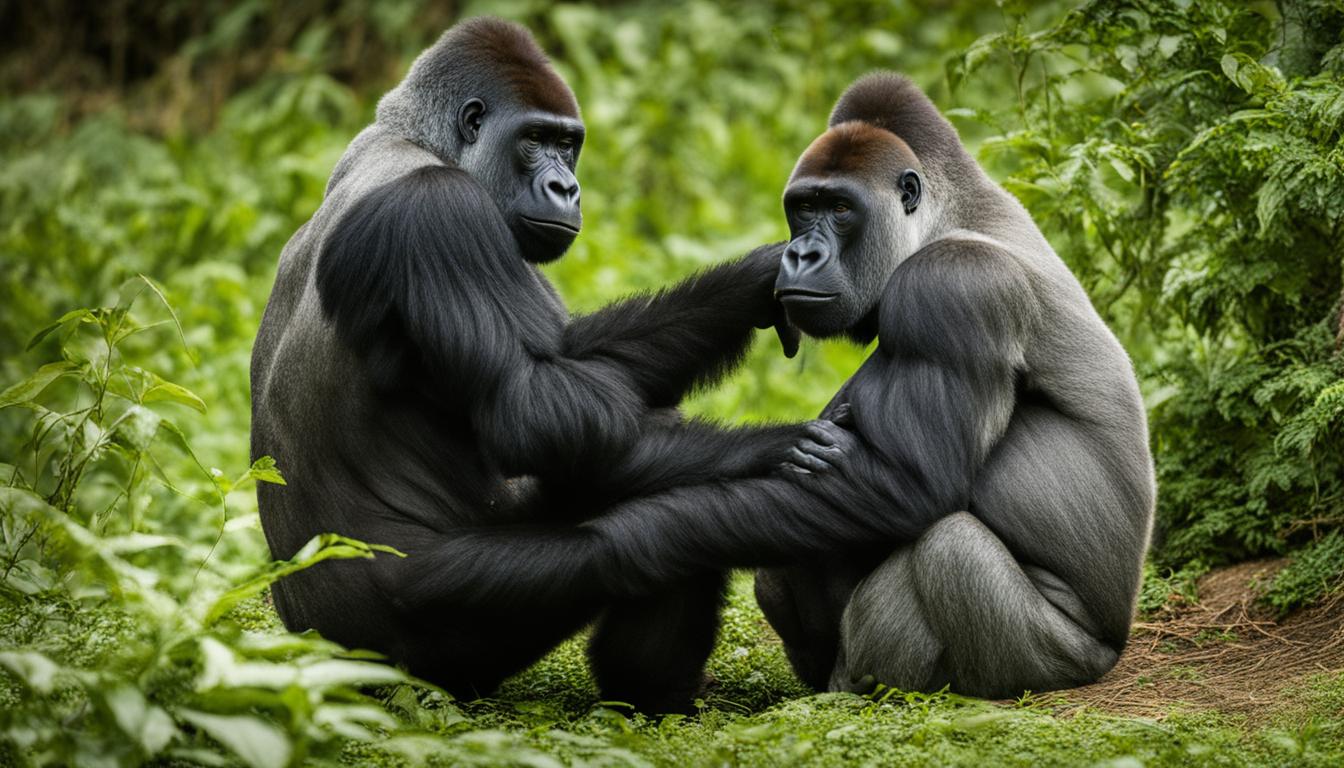Welcome to the first section of our article, where we will explore the fascinating world of gorilla mating habits, reproduction, mate selection, and breeding behavior. Gorillas, the largest ground-dwelling apes, are divided into two main species: the western and eastern gorilla. Living in groups of up to 30 individuals, these magnificent creatures are led by a dominant male silverback.
Gorilla Social Structure and Group Dynamics
Understanding the social structure and group dynamics of gorillas is crucial to gaining insights into their mating and reproductive behaviors. Gorillas live in groups of up to 30 individuals, with a dominant male silverback serving as the leader.
The silverback plays a vital role in the group, determining its actions and protecting the members from threats. Interaction with other groups is rare, but in some cases, it has been observed among western lowland gorillas. The group members generally maintain a peaceful coexistence, allowing the silverback to focus on his leadership responsibilities.
The dominance hierarchy within gorilla groups is evident, with the silverback being the sole male with access to mating with the females. Other males may leave the group and search for their own females. This one-male mating system ensures that the silverback can maximize his reproductive success while preventing potential competition from other males.
Gorilla Dominance Hierarchy
Within the gorilla group, the silverback maintains his dominant position through displays of power and assertiveness. He protects the females and their offspring from any potential threats, establishing his authority through vocalizations, physical displays, and occasionally physical confrontations.
It’s important to note that different gorilla species may exhibit variations in their social structure and group dynamics. While some gorilla populations may have multiple dominant silverbacks within a group, others strictly adhere to the one-male mating system. Additionally, female gorillas may change groups several times during their lifetime to protect their offspring from inbreeding.
| Gorilla Social Structure | Gorilla Group Dynamics |
|---|---|
| Groups of up to 30 individuals | Peaceful coexistence within the group |
| Dominant male silverback as the leader | Rare interaction with other groups |
| One-male mating system | Male gorillas may leave the group to find their own females |
| Multiple silverbacks in some populations | Female gorillas change groups to avoid inbreeding |
“The dominance hierarchy within gorilla groups is evident, with the silverback being the sole male with access to mating with the females.”
Gorilla Reproductive Cycle and Sexual Maturity
The reproductive cycle of gorillas involves complex processes of sexual maturity, ovulation, and estrus. Female gorillas reach sexual maturity at around 10-12 years of age, but they remain infertile until they are mature enough, which is typically around 10 years old. Ovulation occurs earlier, at about 6 years of age, but fertility does not occur until later.
The dominant silverback plays a crucial role in gorilla mating, as he is the only male with access to the females in the group. Mating takes place when the females are ovulating, which is typically initiated by the female gorilla herself. She approaches the dominant male and makes sustained eye contact, pursing her lips to signal her readiness. If the male does not respond, she may even attract his attention by slapping the ground.
However, if the dominant male is too busy or uninterested, the female may be open to mating with other males in the group. In some cases, the silverback may initiate mating by touching the female or making a display with a grunt. Female gorillas may also try to avoid mating with their father to prevent inbreeding and instead mate with less subordinate males within the group.
Gorilla Reproductive Cycle and Sexual Maturity
| Age Milestone | Description |
|---|---|
| 10-12 years | Female gorillas reach sexual maturity. |
| 10 years old | Females become fertile. |
| 6 years old | Ovulation occurs, but fertility does not occur until later. |
Overall, the reproductive cycle of gorillas exhibits a dynamic interplay between the dominant silverback and the females, with specific behaviors and interactions that facilitate successful mating and reproduction. Understanding these processes provides invaluable insights into the complexity of gorilla mating habits and contributes to our knowledge of primate behavior.
Gorilla Mating Rituals and Behaviors
Gorilla mating rituals and behaviors are diverse and fascinating, showcasing the complexity of primate courtship. Mating and breeding among gorillas happen throughout the year, with the dominant silverback having exclusive access to mating with the females in the group. Mating is typically initiated by the female gorilla, who approaches the male and uses visual and physical cues to indicate her readiness. If the male is unresponsive, the female may employ more assertive behaviors to gain his attention. Copulation occurs on the ground, with the male on top of the female, ensuring successful fertilization.
One interesting behavior observed in some gorilla species, such as mountain and western lowland gorillas, is face-to-face mating. During this unique behavior, the individuals make direct eye contact with each other, adding an intimate element to their courtship. Additionally, gorillas engage in sexual behaviors for competition and to prevent other females from conceiving. These behaviors highlight the complex social dynamics within gorilla groups and the strategies employed by females to protect their reproductive success.
To gain a deeper understanding of gorilla mating rituals and behaviors, let’s take a look at the table below, which summarizes some key aspects:
| Aspect | Description |
|---|---|
| Mating Initiation | Usually initiated by the female gorilla, who approaches the male and uses visual and physical cues to indicate readiness. |
| Copulation Position | Mating occurs on the ground, with the male on top of the female. |
| Face-to-Face Mating | Some gorilla species, such as mountain and western lowland gorillas, engage in face-to-face mating, where individuals make direct eye contact. |
| Sexual Behaviors | Gorillas engage in sexual behaviors for competition and to prevent other females from conceiving. |
Understanding gorilla mating rituals and behaviors provides valuable insights into the complex dynamics of primate courtship and reproductive strategies. It showcases the importance of female choice in initiating mating and the variety of behaviors employed by gorillas to ensure successful reproduction.
Gorilla Reproduction and Parenting
Gorilla reproduction and parenting are fascinating aspects of their behavior. Once mating is successful, female gorillas have a gestation period of about 8.5 months. Females give birth to one offspring approximately every four years. The mother plays a crucial role in caring for the infant gorilla, providing it with constant support and protection.
During the first four months, the mother carries the baby gorilla in her hands and breastfeeds it every three hours. This period is crucial for the baby’s development and bond with the mother. After four months, the infant starts riding on the mother’s back and gradually gains confidence to explore short distances away from her. By the age of one, the baby gorilla can move several meters away independently.
At around 30 months, the mother begins to wean the infant, gradually replacing breastfeeding with solid food. This process is essential for the baby’s growth and transition into independence. The infant will eventually make its own nest and become more self-reliant. However, even as the baby grows, it continues to rely on its mother for protection and guidance.
Gorilla Infant Care
Gorilla mothers invest significant time and effort in caring for their infants. They create a nurturing environment through constant physical contact, breastfeeding, and teaching valuable skills. Gorilla infants learn important behaviors and social interactions by observing their mothers and other group members.
The dominant silverback also plays a role in protecting the infants. It ensures their safety by establishing dominance within the group and warding off potential threats from predators or other gorilla groups. This hierarchical structure provides a stable environment for the development and well-being of the infants.
| Gorilla Infant Care | Key Points |
|---|---|
| Breastfeeding | Occurs every three hours in the first four months |
| Mother-Infant Bond | Strong bond formed through constant physical contact |
| Weaning | Gradually introduced solid food at around 30 months |
| Protection | Provided by the dominant silverback and the mother |
| Social Learning | Infants learn important behaviors by observing their mothers and group members |
Factors impacting gorilla mating and reproduction
| Factors | Impact |
|---|---|
| Gorilla mating season | The absence of a specific mating season in gorillas means that mating can occur throughout the year. Unlike other primates that have a defined breeding period, gorillas have the flexibility to mate at any time, which can increase the chances of successful reproduction. |
| Gorilla reproductive strategies | The dominant silverback plays a crucial role in gorilla reproduction. His preference for older, experienced mothers ensures successful and healthier offspring. Competition among females for the attention of the silverback also impacts reproduction, as it influences their chances of mating and passing on their genes. |
| Gorilla mortality rate | Gorilla infants face a high mortality rate, with approximately 40% not surviving to adulthood. Various factors contribute to this, including changes in group dynamics, the arrival of a new silverback, trauma, respiratory infections, and various illnesses. The presence of a new silverback can be particularly detrimental, as he may kill all nursing infants to ensure successful mating with adult females. |
The absence of a specific mating season in gorillas allows for greater reproductive opportunities throughout the year. This flexibility ensures that females have more chances of conceiving and maintaining a healthy population.
The dominant silverback’s reproductive strategies play a crucial role in gorilla mating and reproduction. His preference for older, experienced mothers ensures that the offspring have a higher chance of survival. The competition among females for the attention of the silverback also impacts reproduction, as it influences their chances of successful mating and passing on their genes.
Gorilla infants face a high mortality rate, with various factors contributing to their vulnerability. Changes in group dynamics, the arrival of a new silverback, trauma, respiratory infections, and various illnesses can all impact the survival of gorilla infants. The presence of a new silverback, in particular, can be detrimental, as he may kill all nursing infants to improve his chances of successfully mating with adult females.
Summary:
- Gorillas do not have a specific mating season, allowing for reproductive flexibility throughout the year.
- The dominant silverback’s reproductive strategies, including his preference for older mothers and competition among females, impact gorilla mating and reproduction.
- Gorilla infants face a high mortality rate, with factors such as changes in group dynamics and the arrival of a new silverback contributing to their vulnerability.
Comparison of gorilla mating habits with other primates
Gorilla mating habits stand out among other primates in various ways. Unlike primates with specific mating seasons, gorillas do not have a specific time of year when mating occurs. Instead, mating and breeding can happen throughout the year, depending on the readiness of the females. This flexibility in mating patterns sets gorillas apart from many other primates.
Another distinctive feature of gorilla mating is the dominance of the silverback male. In gorilla groups, the dominant silverback has exclusive access to mating with the females, ensuring that he passes on his genes and maintains his position as the leader of the group. This one-male mating system contrasts with the multi-male mating systems observed in some primate species, where multiple males may mate with a female.
“Gorilla mating habits differ from other primates in their flexibility throughout the year and the dominance of the silverback male.”
Furthermore, female gorillas reach sexual maturity at a later age compared to many other primates. This delayed maturity allows young female gorillas to develop and gain life experience before starting their reproductive journey. When they do reach sexual maturity, it is the females who initiate the mating process by approaching the dominant male, displaying specific behaviors, and making it clear that they are ready to mate.
Lastly, gorillas engage in sexual behavior for competition and to prevent other females from conceiving. This behavior is not as commonly observed in other primate species. The complex interplay of competition, dominance, and mating strategies in gorilla societies adds another layer of uniqueness to their mating habits when compared to other primates.
Table: Comparison of Gorilla Mating Habits with Other Primates
| Primate Species | Mating Season | Mating System | Female Initiation | Sexual Competition |
|---|---|---|---|---|
| Gorillas | No specific season; throughout the year | One-male mating system | Females initiate mating | Engage in sexual behavior for competition and prevention |
| Chimpanzees | Throughout the year | Multi-male mating system | Males and females initiate mating | Engage in sexual behavior for competition and social bonding |
| Bonobos | Throughout the year | Multi-male mating system | Females often initiate mating | Engage in sexual behavior for social bonding and conflict resolution |
| Orangutans | No specific season; throughout the year | One-male mating system | Males initiate mating | Engage in sexual behavior for competition and social bonding |
This table provides a comparative overview of the mating habits of gorillas and other primate species, highlighting the unique characteristics of gorilla mating behavior.

Conclusion
In conclusion, gorilla mating habits in the wild are fascinating and complex, providing valuable insights into primate behavior and reproduction. Gorillas live in groups led by a dominant male silverback, who mates exclusively with the females in the group. Mating occurs throughout the year, and females reach sexual maturity at around 10-12 years of age. The reproductive cycle of female gorillas involves ovulation and fertility occurring at different stages of maturity.
Gorilla mating rituals and behaviors can vary, but it is usually the female who initiates the mating process. Once mating is successful, the female has a gestation period of about 8.5 months and gives birth to one offspring every four years. Gorilla parenting involves the mother caring for the infant, while the dominant silverback provides protection for the group. However, the mortality rate among gorilla infants is high, with approximately 40% not surviving to adulthood.
Various factors can impact gorilla mating and reproduction, including changes in group dynamics, arrival of a new silverback, and illnesses. Despite these challenges, gorillas have adapted unique strategies to ensure successful reproduction in the wild. Overall, the study of gorilla mating habits provides valuable insights into the complexity and diversity of reproductive behaviors in the animal kingdom.
What are the mating and reproductive behaviors of gorillas compared to chimpanzees in the wild?
Gorillas and chimpanzees have different mating and reproduction behaviors. In the wild, gorillas form strong family units led by a dominant silverback male, while chimpanzee mating and reproduction involve complex social dynamics with multiple males and females in a group. These differences reflect their distinct social structures and behaviors.
FAQ
What are the main species of gorillas?
Gorillas are divided into two main species: the western gorilla and the eastern gorilla.
How many gorillas are in a group?
Gorillas live in groups of up to 30 individuals.
Who leads the gorilla group?
The dominant male silverback leads the gorilla group.
At what age do female gorillas reach sexual maturity?
Female gorillas reach sexual maturity at around 10-12 years of age.
How do gorillas choose their mates?
The dominant silverback has exclusive access to mating with the females in the group.
When does mating occur?
Mating occurs throughout the year in gorilla groups.
Who initiates the mating process?
Mating is usually initiated by the female gorilla.
Where does mating occur?
Gorillas mate on the ground, with the male on top of the female.
How long is the gestation period for gorillas?
The gestation period for gorillas is about 8.5 months.
How often do female gorillas give birth?
Female gorillas give birth to one offspring every four years.
How important are mothers for infant gorillas?
Infant gorillas rely heavily on their mothers for survival.
What is the mortality rate among gorilla infants?
The mortality rate among gorilla infants is about 40%.
How do gorillas interact with other groups?
Interaction with other gorilla groups is rare but sometimes observed in certain gorilla populations.
Why do female gorillas change groups?
Female gorillas may change groups multiple times during their lifetime to protect their offspring and avoid inbreeding.
When do female gorillas become fertile?
Female gorillas become fertile at around 10 years old.
Who has access to mating with the females in the group?
The dominant silverback is the only male with access to mating with the females in the group.
What factors can impact gorilla mating and reproduction?
Various factors such as changes in group dynamics, arrival of a new silverback, trauma, respiratory infections, and illnesses can impact gorilla mating and reproduction.
How do gorilla mating habits compare to other primates?
Gorilla mating habits differ from other primates in specific ways, such as not having a specific mating season and the dominant silverback mating with all the females in the group.







